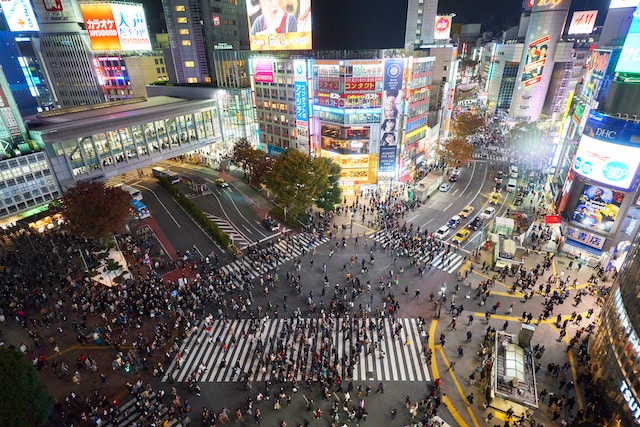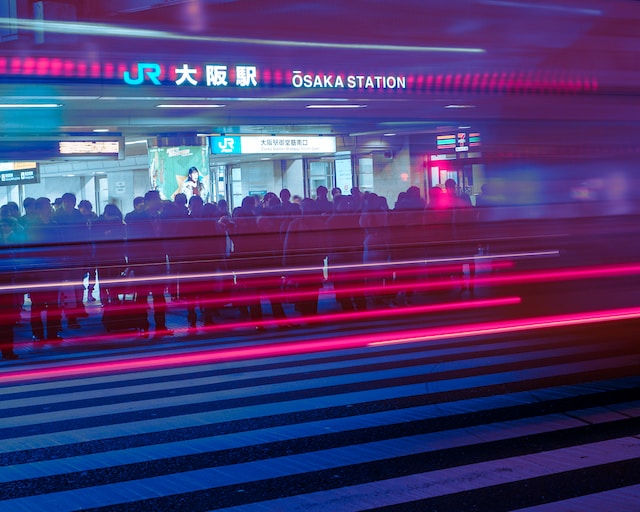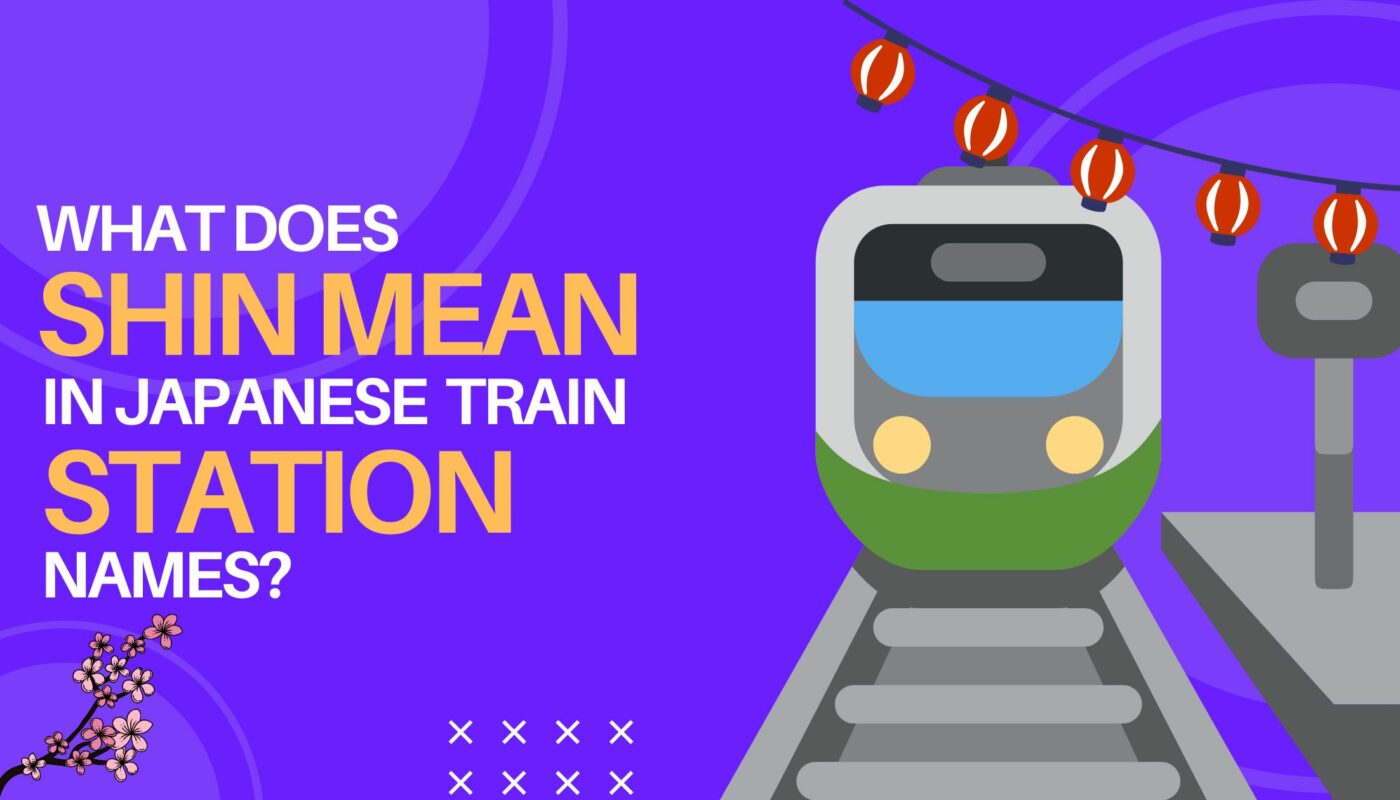Have you ever wondered about the meaning behind the names of Japanese train stations? More specifically, what does the word “shin” mean when it appears in station names?
Understanding the significance of “shin” in Japanese train station names can provide valuable insights into the evolution and development of Japan’s railway system.
So, let’s delve into the meaning of “shin” and unravel the fascinating stories behind these station names in this article.
What Does Shin Mean In Japanese Train Station Names?
The word “Shin” is a Japanese term that translates to “new.” As such, when it’s included in the name of a train station, it often indicates that the station is a newer or more recently constructed station in comparison to another station with a similar name.
These “Shin” stations are typically built to accommodate increased passenger traffic, urban development, or improved transportation networks.
Shin stations are generally larger, more modern facilities with additional features such as multiple platforms, modern amenities, and better accessibility for the disabled.
Some Shin stations include Tokyo’s Takadanobaba Station, Osaka’sTennoji Station, and Kyoto’s Demachiyanagi Station.
Note📝: These stations are all larger, modern facilities that have been built to accommodate the needs of a growing population and improved transportation networks.
What Does “Shin” Mean In Japanese?
The Japanese word “Shin” is a versatile word in the Japanese language that can be expressed with various kanji characters, each carrying a different meaning. One interpretation of “Shin” is “真,” which translates to “true” and signifies authenticity or genuineness.
Another possible kanji character is “伸,” which means “extend” and conveys the idea of stretching or lengthening.
Additionally, “新” is another kanji character associated with “Shin,” representing “new” and symbolizing freshness or novelty.
Lastly, “心” is yet another kanji character that can represent “Shin” and signifies “heart,” implying emotions, feelings, or the essence of a person.
What Is The Significance Of Shin Stations?

The significance of Shin Stations lies in their modern facilities, enhanced connectivity, increased capacity, economic and urban development opportunities, transportation network integration, gateway to cities, and high-speed rail access. These stations have revolutionized the way people travel and commute in Japan by providing an efficient and cost-effective transport system.
Modern facilities such as comfortable waiting areas with high-speed internet access, restaurants, retail stores, and ATMs have made these stations a popular destination for travelers.
The enhanced connectivity provided by Shin Stations has enabled people to easily transfer between different lines and modes of transportation, making it easier to reach their desired destination quickly and conveniently.
This increased capacity has also reduced traffic congestion in the cities, leading to an improved quality of life.
Shin Stations have also been instrumental in economic and urban development.
The presence of these stations has encouraged investment in real estate while providing access to employment opportunities for local citizens.
The transportation network integration provided by Shin Stations has further improved public transportation links, with high-speed rail lines connecting cities and towns across Japan.
Does The Japan Rail Pass Work For Shin Staions?
The answer is yes, the Japan Rail Pass works for Shin stations. The Japan Rail Pass covers all JR Group limited express trains, express trains, rapid and local ones. This includes the Shinkansen bullet trains, which are also covered by the pass.
However, it is important to note that the NOZOMI and MIZUHO trains are not covered by the Japan Rail Pass.
What Are The Different Shin Stations In Japan?
Some of the most notable ones include Tokyo Station, which is a major transportation hub in the capital city. Other Shin Stations include Shin-Osaka Station, which is a gateway to the western part of Japan, and Shinjuku Station, one of the busiest stations in Tokyo.
These Shin Stations are known for their modern facilities, efficient transportation services, and convenient connections to various destinations in Japan.
Here, is a list of different Shin Stations in Japan:
Shinjuku Station (新宿駅):
Located in Tokyo’s western suburbs and connected to the city’s downtown area by several rail lines, Shinjuku Station is the world’s busiest railway station.
It offers access to numerous express trains and serves as a hub for regional train services, with connections throughout Tokyo and neighboring prefectures.
Shin-Osaka Station (新大阪駅):
Shin-Osaka Station is one of the major transportation hubs in Osaka, providing access to the Shinkansen (bullet train) lines that connect Osaka with Tokyo and other cities in Japan.
It is connected to several local railway lines, allowing commuters to access nearby suburbs and cities.
Shin-Yokohama Station (新横浜駅):
Shin-Yokohama Station is located in Yokohama, a city located to the south of Tokyo.
It serves as a major terminal for the Yokohama Line, offering express and local services to nearby cities and suburbs.
Shinagawa Station (品川駅):
Shinagawa Station is one of the largest railway stations in Tokyo, serving as a hub for several lines that connect it with the city’s downtown areas and suburbs.
It is also a major terminus for the Shinkansen lines that run between Tokyo and other cities in Japan.
Shin-Kobe Station (新神戸駅):
Shin-Kobe Station is located in the city of Kobe, on the main island of Honshu.
The station provides access to several express and local trains that connect Kobe with other cities in the Kansai region, including Osaka, Kyoto and Nagoya.
Shin-Hakodate-Hokuto Station (新函館北斗駅):
Shin-Hakodate-Hokuto Station is located in the city of Hakodate, on the island of Hokkaido.
It serves as a terminus for the Shinkansen line that connects it with Tokyo and other cities in Japan, as well as several local railway lines.
Shin-Tokyo Station (新東京駅):
Shin-Tokyo Station is located in the city of Tokyo, providing access to the Shinkansen lines that connect it with other cities in Japan.
It also serves as a hub for several local railway lines, offering access to the city’s downtown area and suburbs.
Shin-Kawasaki Station (新川崎駅):
Shin-Kawasaki Station is located in the city of Kawasaki, in the Greater Tokyo Area.
It provides access to several express and local services that connect Kawasaki with nearby cities and suburbs, as well as the Shinkansen lines that run between Tokyo and other cities in Japan.
Shin-Urayasu Station (新浦安駅):
Shin-Urayasu Station is located in Urayasu, a city in the Greater Tokyo Area.
It serves as a major hub for several railway lines that connect it with central Tokyo, as well as other cities and towns in the region.
Shin-Sapporo Station (新札幌駅):
Shin-Sapporo Station is located in the city of Sapporo, on the northern island of Hokkaido.
It serves as a major hub for local railway services and offers access to several express trains that connect it with Tokyo and other cities in Japan.
What Is The Difference Between Osaka Station And Shin-Osaka Station?

Osaka and Shin-Osaka are two of the busiest rail stations in Japan. However, the average traveler may not know the difference between them. Located four kilometers apart, Osaka Station is the main hub for all local commuter trains and subways while Shin-Osaka Station is where the Shinkansen stops.
To add to the confusion, Umeda Station is located right next to Osaka Station and is where all the other train companies’ trains stop.
Here Is A Look at The Key Differences Between Osaka Station and Shin-Osaka Station:
| Aspect | Osaka Station | Shin-Osaka Station |
| Location | Heart of downtown Osaka | Northern side of the city |
| Train Lines Served | Local commuter trains and subways | Terminus for Shinkansen lines |
| Connections | JR West and private railway lines | Direct access to Shinkansen lines |
| Nearby Stations | Umeda Station (adjacent, other train companies) | No other nearby stations |
Can You Use The Japan Rail Pass from Shin Osaka to Osaka?
Yes, you can use the Japan Rail Pass from Shin-Osaka to Osaka. Although the Shinkansen trains do not directly travel to Osaka Station or on the Osaka Loop Line, there is a convenient option available. You can take a Rapid Express JR train from Shin-Osaka to reach downtown Osaka Station.
This train journey is covered by the Japan Rail Pass, making it a convenient and cost-effective way to travel between the two stations.
How Many Different Train Systems Are There In Japan?
In general, there are five types of train systems in Japan. The first and most well-known is the Shinkansen, also known as the bullet train, which is the fastest and most efficient mode of transportation in the country. The second type is limited express trains.
Express trains are faster and more comfortable than regular express trains and are often used for long-distance travel.
The third type is express trains, which are slightly slower than limited express trains but still provide a relatively fast and comfortable journey.
The fourth type is rapid trains, which are used for shorter distances and make more frequent stops.
Lastly, there are local trains, which are the slowest and make stops at every station along the route.
Each type of train system serves different purposes and caters to different needs of passengers in Japan.
| Train System | Description |
| Shinkansen (Bullet Train) | Fastest and most efficient mode of transportation |
| Limited Express Trains | Faster and more comfortable than regular express trains |
| Express Trains | Slightly slower but still relatively fast and comfortable |
| Rapid Trains | Used for shorter distances, more frequent stops |
| Local Trains | Slowest, stops at every station along the route |
FAQs
Is Shin-Osaka The Same As Osaka?
No, Shin-Osaka is not the same as Osaka. Shin-Osaka is a district located in the northern part of Osaka City, Japan. It is primarily known for its transportation hub, Shin-Osaka Station, which serves as a major railway station connecting Osaka with other cities in Japan.
On the other hand, Osaka is a larger city and the capital of Osaka Prefecture.
It is a vibrant and bustling metropolis, known for its rich history, modern architecture, and vibrant food and entertainment scene.
While Shin-Osaka is a part of Osaka, they are distinct in terms of their geographical locations and the specific attractions and features they offer.
Why Isn’t The Shin-Osaka Station Named The New Osaka Station?
The Shin-Osaka Station is not named the New Osaka Station because the names of Japanese railway stations are translated directly into the Roman alphabet. Hence, they can be read and spoken as they are in Japanese. In Japanese, “shin” means “new,” but it is pronounced differently than the English word “new.”
The naming convention aims to preserve the original pronunciation and meaning of the station names in Japanese, rather than translating them into English equivalents.
Therefore, the station is referred to as Shin-Osaka Station to maintain its authenticity and cultural significance.
Conclusion
In essence, “Shin” in Japanese train station names signifies more than novelty. It encapsulates modernity, connectivity, and urban growth. These stations are not just new; they’re strategic transportation hubs with advanced facilities.
They underscore Japan’s commitment to efficient travel, urban development, and seamless integration.
By understanding the depth of “Shin,” we unveil Japan’s dedication to enhancing travel experiences and fostering thriving communities.







